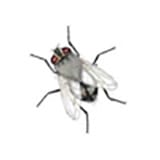
Nuisance and Biting Flies
Cluster Fly, Face Fly, Stable Fly and Mosquitoes
How to get rid of biting flies that are a nuisance with fly deterrents.
Biting Fly Identification
Many commonly found flies found around the home are a nuisance and or bite. As with many flies, these flies breed on decaying organic matter and animal wastes.
They may transmit bacteria and viruses to humans.
Flies such as stable flies or horse flies (sometimes called "biting flies") feed on mammalian blood and can give a painful bite.
Flies such as the cluster flies and face flies may become a nuisance but don't bite. Other flies, such a stable flies or horse flies, can be called biting flies because of their painful bites. Other biting flies include mosquitoes, sand flies, black flies, and deer flies.
It is challenging to battle these biting flies because it is difficult to control the breeding sites since they breed in water areas such as ponds and swamps. It is suggested that you contact your local mosquito control district to see what is provided in managing their breeding sources. Stable flies breed in decaying grass or crop clippings, hay residues, and silage. Because they are powerful fliers, the infestation source may be located up to several hundred miles away. It is somewhat difficult to control stable flies.
Prevention ( Avoid outdoor activity during these peak biting times)
-
Horseflies Deer flies, Black flies, and Stable flies are most active during the day.
-
Sandflies are most active around sunrise or sunset.
-
Deer flies and black flies are most prevalent in early to late spring. Stable flies are most abundant in late August through October or November. Sandflies are most abundant during the summer months but may bite at any time during the year.
-
Mosquitoes thrive in tropical weather, but are found throughout the USA. Many species (not all) rest during the day in dense vegetation such as tall grass, weeds, and shrubs. Any successful mosquito control program should target these areas.
Get Rid Of and Deter Biting Flies
- Increasing air movement in porches, patios, and picnic areas will keep biting flies away but will not usually provide complete protection.
- Burning candles, coils, and torches containing citronella or other biting fly repellents will sometimes reduce bites. Burning these items produce smoke that repels biting insects.
- Most biting flies will usually rest on low vegetation until they detect a host. Pruning shrubs, mowing weedy areas, and opening up the airflow environment will reduce the number of biting flies in an area.
- Despite all efforts, biting flies may still be a problem. If biting flies get inside the house, space sprays can be applied to kill them. Aerosols such as space sprays, like Styker 54, CB 80, or PT 565 may be used to kill on contact.
- Remove all people and pets from rooms, turn off air handling systems, apply the product according to label directions, and wait about 10-15 minutes before aerating the room. Keep room vacant as long as the label recommends.
-
Crack and crevice residual insecticide treatments can be used.
Related Products
Written by our resident pest control expert Ken Martin.










